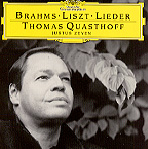Successful lieder singing–that is, the kind that makes listeners want to keep listening–is one of the more difficult musical/artistic undertakings. No sets and costumes, no orchestra, no dramatic staging. Besides technique, it requires a repertoire of vocal color and a wide expressive range. It demands a capacity to understand the communicative and emotive heart of a song and how to do the things that personalize it without subtracting from the music or text. Sheer beauty of voice is not enough, contrary to what some singers think when performing songs. Baritone Thomas Quasthoff is not exactly a newcomer to the art of solo song, but here he proves that he’s one of the best, at least in this repertoire. And that’s saying something, because these songs are anything but light fare–even though among them are some of these two composers’ more lyrical and lovely statements in the genre. Quasthoff approaches each song as a fresh, first-told story that lives or dies for the listener by virtue of the storyteller’s skill. He commands your attention with his strong and sturdy baritone, which ranges from warm and fluid to penetratingly resonant–always tastefully, thoughtfully used. He is especially effective in the Brahms songs, which just seem like home territory, like he’s lived with and in these pieces for a long time. The Liszt Petrarch songs are more challenging than beautiful. Indeed, the Italian doesn’t flow as smoothly as German for Quasthoff, but his command of the music is solid, and he gets to (convincingly) demonstrate the high end of his vocal range and his dramatic flair. He offers some of his most beautiful singing in the other three Liszt pieces, leaving us with an especially wonderful rendition of “Es muss ein Winderbares sein”–a virtually unknown little gem, and a perfect concert closer.
In song recitals, often the crucial third partner, the piano, proves to be the weak link. It does here, but only to a small degree. This is not the fault of the pianist, Justus Zeyen, who in fact is an outstanding, sensitive, unfailingly musical, and in all respects ideal collaborator for Quasthoff. But the engineering is not so kind to the piano’s high end–a kind of clinky quality–and this is too bad because every other aspect of the sound, including the balance, is absolutely fine. Interestingly, there is no true competition for this program on disc. While this may be understandable for the Liszt, whose recorded songs unfortunately tend to be limited to a handful of concert fillers, it’s inexplicable for the Brahms, whose other vocal works for the most part have been very well treated. All the better, then for having these first rate performances in the catalog.
































